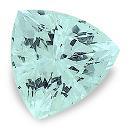|
|
||||||||||||||||
|
||||||||||||||||
|
||||||
|
|
|
|
Aquamarine
(a
variety
of Beryl) |
|
| | |
| Discovery: Prehistoric; IMA status: Not Valid (a variety of Beryl) | ||
|
| ||
|
Chemistry |
|
|
| |
|
Be3Al2Si6O18 + Fe | |
|
|
Beryllium Aluminum Silicate + Iron |
|
Molecular Weight: |
537.50 gm |
|
Composition: |
Beryllium |
5.03 % |
Be |
13.96 % |
BeO |
|
|
Aluminum |
10.04 % |
Al |
18.97 % |
Al2O3 |
|
|
Silicon |
31.35 % |
Si |
67.07 % |
SiO2 |
|
|
Oxygen |
53.58 % |
O |
|
|
|
|
|
100.00 % |
|
100.00 % |
= TOTAL OXIDE |
|
|
|
||||
|
Classification |
|
|
| |
|
Silicates (Germanates) | |
|
8/E.12-10 | |
|
|
9 : SILICATES (Germanates)
|
|
Related to: |
Beryl Group. Beryl Series. |
|
Members of Group: |
Beryl Group: Bazzite, Beryl, Pezzottaite, Stoppaniite |
|
Varieties: |
Aeroides, Alkali-beryl, Améthiste Basaltine (of Egleston), Aquamarine, Emerald, Goshenite, Heliodor, Maxixe-Aquamarine, Morganite, Pachea, Red Beryl (Bixbite), Riesling Beryl, Vorobyevite |
|
Synonyms: |
Berylite, Berylle, Berylls |
|
|
|
|
Crystal Data |
|
|
|
|
|
Crystals prismatic to tabular, with {1010}, {0001}, and {1120}; may be complexly terminated by pyramids, to 18 m and 180 t. Also radial, trapiche, columnar; granular to compact. |
|
|
Rarely |
|
|
|
|
|
Physical Properties |
|
|
|
|
|
Imperfect on {0001} |
|
|
Conchoidal |
|
|
Brittle |
|
|
7.5 - 8.0 |
|
|
2.66 - 2.80 (g/cm3) |
|
|
None |
|
|
Not Radioactive |
|
|
|
|
|
Optical Properties |
|
|
|
|
|
Various shades of pale Blue to Blue-Green; Colorless in thin section |
|
|
Transparent to Translucent |
|
|
Vitreous, Resinous |
|
|
1.567 - 1.590 Uniaxial ( - ) |
|
|
0.005 - 0.007 |
|
|
0.014 (low) |
|
|
Weak to distinct; O = colorless, yellowish green, light blue, yellowish red; E = sea-green, blue |
|
|
|
|
|
Occurances |
|
|
|
|
|
Geological Setting: |
In granites and granite pegmatites, rarely in nepheline syenites. Also in mafic metamorphic rocks, low- to high-temperature hydrothermal veins. |
|
Common Associations: |
Quartz, Feldspar, Muscovite, Lepidolite, Spodumene, Amblygonite, Tourmaline, Topaz, Cassiterite, Columbite, Tantalite. |
|
Common Impurities: |
Fe, Mn, Mg, Ca, Cr, Na, Li, Cs, O, H, OH, H2O, K, Rb |
|
Type Locality: |
Unknown (prehistoric) |
|
Year Discovered: |
Prehistoric |
|
View mineral photos: | |
|
|
|
|
More Information |
|
|
|
|
|
|
Mindat.org
(Aquamarine) |
|
|
|
|
Aquamarine
is known from many sources worldwide including Afghanistan;
Australia; Minas Gerais and other locations in Brazil;
more than fifty specific locations in Madagascar; Myanmar
(Burma); Namibia; Pakistan; Russia; Sri Lanka; and in
the USA at San Diego County, California; Mt. Antero,
Colorado; Connecticut; Maine; and North Carolina. |
|
|
We
have not photographed our Aquamarine gems yet. Please
check back soon! |
